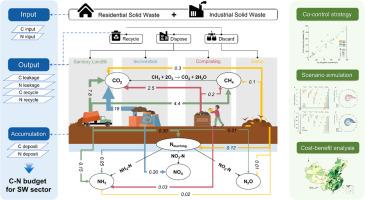管理固体废物,共同控制中国的碳氮泄漏
IF 10.9
1区 环境科学与生态学
Q1 ENGINEERING, ENVIRONMENTAL
引用次数: 0
摘要
固体废物处理产生大量的碳和氮泄漏,对空气质量、水生生态系统和气候产生不利影响。然而,该部门碳和氮的耦合循环仍然没有得到充分的了解。本研究建立了1980 - 2023年中国固体废物部门的碳氮综合预算。在此期间,大气碳排放量增加了3.6倍,在2023年达到3400万吨(Tg) C /年,而氮损失在2005年达到1.4 Tg N /年的峰值,随后下降。到2060年,优化的协同控制策略可以减少87%的碳泄漏(30.2 Tg N -1)和96%的氮泄漏(0.9 Tg N -1),产生346亿美元的净社会效益。减少源头战略,特别是废物回收计划和按垃圾量付费的关税,是最具成本效益的缓解办法。这些调查结果强调了固体废物管理在促进循环经济和实现可持续发展方面的关键作用。本文章由计算机程序翻译,如有差异,请以英文原文为准。

Managing solid waste to co-control carbon and nitrogen leakage in China
Solid waste disposal generates substantial carbon and nitrogen leakage, adversely affecting air quality, aquatic ecosystems, and the climate. However, the coupled cycles of carbon and nitrogen within this sector remain insufficiently understood. This study develops an integrated carbon and nitrogen budget for China’s solid waste sector from 1980 to 2023. Over this period, atmospheric carbon emissions increased 3.6-fold, reaching 34.0 million tons (Tg) C yr-1 in 2023, while nitrogen losses peaked at 1.4 Tg N yr-1 in 2005 before declining. By 2060, an optimized co-control strategy could reduce carbon leakage by 87 % (30.2 Tg C yr-1) and nitrogen leakage by 96 % (0.9 Tg N yr-1), yielding net social benefits of US$34.6 billion. Source reduction strategies, particularly waste recovery programs and Pay-As-You-Throw tariffs, are the most cost-effective mitigation options. These findings underscore the critical role of solid waste management in promoting a circular economy and achieving sustainable development.
求助全文
通过发布文献求助,成功后即可免费获取论文全文。
去求助
来源期刊

Resources Conservation and Recycling
环境科学-工程:环境
CiteScore
22.90
自引率
6.10%
发文量
625
审稿时长
23 days
期刊介绍:
The journal Resources, Conservation & Recycling welcomes contributions from research, which consider sustainable management and conservation of resources. The journal prioritizes understanding the transformation processes crucial for transitioning toward more sustainable production and consumption systems. It highlights technological, economic, institutional, and policy aspects related to specific resource management practices such as conservation, recycling, and resource substitution, as well as broader strategies like improving resource productivity and restructuring production and consumption patterns.
Contributions may address regional, national, or international scales and can range from individual resources or technologies to entire sectors or systems. Authors are encouraged to explore scientific and methodological issues alongside practical, environmental, and economic implications. However, manuscripts focusing solely on laboratory experiments without discussing their broader implications will not be considered for publication in the journal.
 求助内容:
求助内容: 应助结果提醒方式:
应助结果提醒方式:


